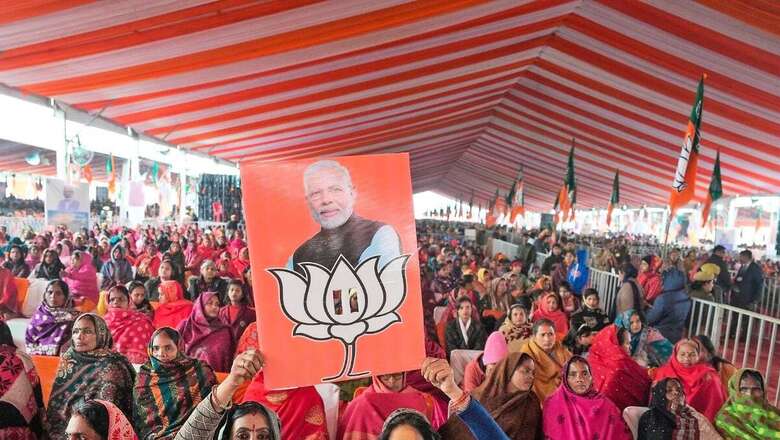Opinion | Murder in Hubballi to Mangalsutras: Does Hindu Vote Consolidation Hold the Key to Phase 2?

views
If Phase 1 was deemed the trickiest for the BJP, then the second phase of the Lok Sabha elections should ordinarily pose no hurdles for the saffron party. In 2019, the BJP had contested 72 out of a total of 88 seats that will go to the polls in Phase 2. It won 52 of the 72 seats. That’s a whopping 74 per cent conversion rate. Besides, in 56 of these seats, including the four it lost, the BJP had a vote share of more than 40 per cent.
But Indian voters are famously inscrutable. And they’ve lived up to their reputation this time around too by demonstrating a marked reluctance to come out and vote in Phase 1. The no-shows are surprising as the 2024 clash has been billed by the contenders as the most consequential election in a decade. Political party tacticians and political pundits don’t quite know what to make of it.
Did people not vote enthusiastically because the result is foretold? Did they absent themselves because, while they are enamoured with Modi, they are disaffected enough with his party’s performance to want to send a silent message of protest? But then, some ask, wouldn’t sulking voters have sent a clearer message by turning up and pressing the NOTA button? Others attribute the cop-out in Phase 1 to the scorching heat and the harvest season. But then why didn’t the very same factors depress turnouts in 2019? There are no simple answers.
Conventionally, low turnouts have been associated with voter apathy but not anger as such. Angry voters keen to throw out an incumbent make a big show. Whatever the reason, this much is true, low turnouts hurt those parties hoping to cash in on anti-incumbency or those that lack a strong organisational base that can shepherd voters to the polling booth. This is not a problem one usually associates with an ideologically motivated cadre-based party like the BJP.
Naturally, leaving nothing to chance, the Modi campaign has gone for broke. In the last week, right from the day Phase 1 ended, Modi has ratcheted up the rhetoric. Most notable are Modi’s polarising speeches on the Congress party’s alleged “anti-Hindu manifesto” that according to the prime minister is designed to “loot mangalsutras” and hand them over to those with more than “three children”. Was Modi playing the Hindu card to rally the BJP’s base around Hindutva tropes in an election without any one single issue?
And then just as the shell-shocked Opposition complained to the Election Commission about what they termed as Modi’s “bigotry”, the prime minister proceeded to shake the urban middle class out of its ennui. In a stump speech, he alleged that the Congress was planning to redistribute public wealth by conducting surveys and imposing an inheritance tax. Again, the prime minister hinted at minorities corralling the lion’s share. The subject was trending relentlessly on X and captured the headlines. But will the fear of losing wealth to a prospective Congress government excite the middle class to come out and vote? This remains an imponderable question pregnant with suspense.
Some experts are viewing the prime minister’s barb firing spree as a sign of panic. Public facing grandiose claims of “abki baar 400 paar” aside, the prospect of a lukewarm turnout is no doubt bothering the BJP. While the extent of concern in BJP ranks is debatable, the saffron outfit is aware that its core voter needs to be galvanised into action. And if the statistics are to be believed, this is urgently required in this phase itself.
Despite the BJP’s dominance in 2019 across Phase 2 seats, there are several seats where the BJP eked out a win with the slimmest of margins. Of these, seven stand out. Meerut in Uttar Pradesh, Nowgong in Assam, Kanker in Chhattisgarh, Chamarajanagar and Tumkur in Karnataka, and Alappuzha and Palakkad in Kerala.
According to widely published Election Commission data in a recent media report, the BJP won Chamarajanagar, Meerut, and Kanker by only 0.14 per cent, 0.39 per cent, and 0.6 per cent respectively in the last elections. A low turnout fuelled by complacent BJP voters could throw open the contests in these seven seats.
At least that’s what the Congress will be hoping.
In 2019, in seats across Phase 2, the Congress only won 18 seats. In fact, across Phase 2 seats, the party’s share of seats has dipped by 19 seats or 50 per cent over a decade since 2009. This is bad news for the Congress, particularly when one considers that in 2019, of the 18 seats it holds over Phase 2, a huge number – 16 were won only from Kerala. The Kerala bump has been attributed to the fact that Rahul Gandhi contested from Wayanad in the state. If one were to remove Kerala from the equation, the Congress would be left with a measly two seats. This time the contest in Kerala could be closer given that aside from the BJP, the Left is contesting separately, leading to triangular matches involving the Congress in many seats.
The BJP will hope that the Congress party’s graph continues to slide in Phase 2. But if the BJP is to score a thumping majority, then it must retain its 19 safe seats (where it won in 2009, 2014, 2019) in this phase. But more importantly, the BJP needs to get its voters out in 24 swing seats. These are seats that the BJP has won only twice since the 2009 Lok Sabha polls. A number of these swing seats are in Karnataka. In the 2019 contest, the BJP all but swept Karnataka’s 28 seats.
But this time, the BJP is a divided house in Karnataka and is up against a resurgent Congress that had wrested the state from the BJP in the 2023 Assembly election. With the momentum against it, the BJP is desperately in need of an issue, preferably one with polarising potential.
Could the gruesome murder of a young Hindu woman at the hands of a Muslim man be that issue? The BJP immediately pounced upon the murder declaring it an act of “love jihad” and accused the Congress of not taking a stand because of its dependence on Muslim votes. The BJP is seeing the murder as just the latest in a series of incidents – the Rameshwaram Cafe blast triggered by Islamists and the chanting of pro-Pak slogans in the premises of the state legislature by Congress leaders – where radical Muslims think they can act with impunity.
Setbacks in Karnataka for the BJP will have a spillover effect in some pockets of Maharashtra, Telangana and Madhya Pradesh. A poor show in Karnataka will also be a verdict on the Modi wave or the lack of one. This analysis also holds true even for Maharashtra where eight out 48 seats will see a contest in Phase 2. Maharashtra sends the greatest number of MPs to the Lok Sabha after Uttar Pradesh. Here too, the BJP did well in 2019 in partnership with then ally – the Shiv Sena – led by Uddhav Thackeray. The Shiv Sena since then has split. The Opposition in Maharashtra has suffered the same fate. Sharad Pawar’s original NCP also broke up with the supremo’s nephew running away with half the party and ending up with the NDA.
Most analysts are convinced that Maharashtra and Karnataka hold the key to the 2024 election result. Phase 2, then, could be where the seeds of the next Lok Sabha are being sown.
Views expressed in the above piece are personal and solely those of the author. They do not necessarily reflect News18’s views.




















Comments
0 comment